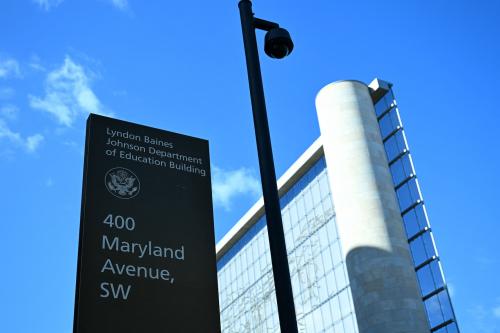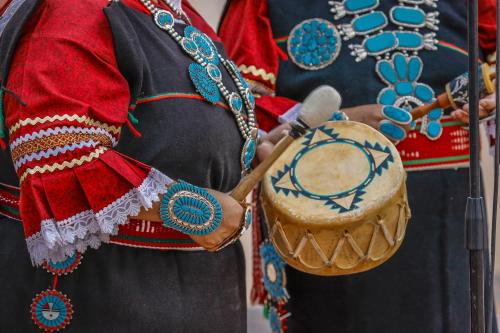In the often-contradictory foreign analyses of China’s 17th Party Congress, there was a surprising level of consensus that the composition of the Politburo of the Communist Party of China (CPC), especially its Standing Committee, is a crucial factor in determining the political trajectory of the country. This explains why considerable media attention has been given to personnel changes in these leadership institutions. In fact, one notable phenomenon at the Congress is Chinese authorities’ growing emphasis on “collective leadership.” As General-Secretary Hu Jintao stated in his report to the Party Congress, the CPC should improve the system of “collective leadership with division of responsibilities among individuals” in an effort to “prevent arbitrary decision-making by an individual or a minority of people in the Party.”
The most important development coming out of the 17th Party Congress is the new succession model with two candidates rather than one designated “heir apparent.” Two front-runners in the so-called fifth generation of leaders, 54-year-old Xi Jinping and 52-year-old Li Keqiang, were elevated to the Politburo Standing Committee. Meanwhile, another six members in their 50s obtained seats on the Politburo and/or the Secretariat. These eight rising stars collectively have formed a “succession team” set to take over from the fourth generation of leaders in 2012-2013. All of these developments seem to indicate that the country has entered a new era of collective leadership. Consequently, the rules and norms of Chinese elite politics are likely to change profoundly. What does collective leadership mean for China’s future? Is it a cause for celebration or anxiety?
The transition in China from an all-powerful single leader to collective leadership has been a gradual process. Mao Zedong wielded enormous power as a god-like figure, especially during the Cultural Revolution, treating succession as if it was his private matter. During the Deng Era, political succession and generational change in the Chinese leadership became a matter of public concern. Yet, because of his legendary political career and his formidable patron-client ties, Deng Xiaoping maintained his role as China’s paramount leader even when he did not hold any important leadership position following the Tiananmen incident. Both Jiang Zemin and Hu Jintao are technocrats who lack the charisma and revolutionary credentials of Deng, but both have had broad administrative experiences and are good at coalition-building and political compromise. Nevertheless, both Jiang and Hu had the endorsement of Deng. The evolution of the four generations of Chinese leaders illustrates a consistent trend towards a more collective leadership, and away from “strong-man” politics.
The profound shift in the source and legitimacy of leadership becomes even more salient for the emerging fifth generation of leaders. Many of the rising stars of the new generation share similarities in terms of leadership credentials, but differ significantly with respect to socio-political backgrounds and career paths. For instance, frontrunners Xi Jinping and Li Keqiang both joined the CPC in the mid-1970s, hold Ph.D. degrees, have been on the Central Committee of the CPC for ten years, and have served as Party secretaries for two provincial level administrations. Yet, Xi was born into the family of a prominent Communist veteran leader whereas Li comes from a humble family background. Xi made giant strides in his career through urban economic administration while Li advanced his political career largely through the Chinese Communist Youth League (CCYL). While Xi ran some of the most advanced economic regions in the country such as Fujian, Zhejiang, and Shanghai, Li’s provincial experiences were spent first in poor and agricultural Henan and then in rustbelt industrial-base Liaoning.
The characteristics – and the contrasts – of Xi and Li are quite representative of their age cohorts in the new leadership. A majority of the first-timers in the Politburo have substantial leadership experience in provincial administration. The number of the Politburo members with experience as provincial chiefs increased from 10 (50%) in the 14th Politburo to 13 (59%) in the 15th Politburo, 16 (67%) in the 16th Politburo and 19 (76%) in the 17th Politburo. These statistics reflect dynamic changes in the relationship between the central and local governments in present-day China and the growing importance of provincial leadership in Chinese politics.
Among the eight rising stars in the Politburo and the Secretariat, four advanced their careers through the ranks of the CCYL and four – referred to as “princelings” – come from high-ranking family backgrounds. On the 371-member Central Committee, a total of 86 leaders previously served in the provincial or national leadership of the CCYL. Most of them began their careers through grassroots CPC branches and climbed step-by-step through rural administration, Party organization, or propaganda work in inland provinces. Meanwhile, 32 leaders are princelings, and they usually have substantial experience in urban economic development, finance, foreign trade, diplomacy, science and technology, and/or military affairs.
With respect to their educational backgrounds, leaders from the fifth generation are much more diverse than those from the third and fourth generations, who were predominantly technocrats. The eight rising stars have very diverse academic training: Xi Jinping and Li Yuanchao in law, Li Keqiang in economics, Wang Qishan in history, Wang Yang in management, Bo Xilai in journalism, Ling Jihua in business administration, and Wang Huning in political science. This is in sharp contrast to the previous Politburo Standing Committee, where all nine members were engineers by training. In addition, the number of foreign-educated returnees increased from 20 on the 16th Central Committee to 36 on the 17th Central Committee. For example, Minister of Education Zhou Ji received his Ph.D. in engineering at the State University of New York at Albany in 1984. Two leaders currently in charge of the CPC organization and propaganda affairs, Li Yuanchao and Wang Huning, both studied in the United States as visiting scholars.
Entrepreneurs, another emerging elite group, have also increased from nine on the 16th Central Committee to eighteen on the 17th Central Committee. Most of these entrepreneurs currently hold positions as CEOs of China’s flagship state firms, but a few actually head joint ventures and private companies. Most of these entrepreneurs are quite young, including Su Shulin (45-year-old CEO of SINOPEC), Zhu Yanfeng (46-year-old CEO of China First Auto Works), and Wang Xiaochu (49-year-old CEO of China Telecom). The rapid increase of relatively young entrepreneurs on the Central Committee suggests that these leaders will likely play an increasingly prominent role in Chinese elite politics in the years to come.
Paralleling the diverse political career paths and the growing diversity of educational and professional backgrounds of the fifth generation of leaders is the broad transformation in Chinese society after three decades of market reform. On one hand, China has a fast-growing entrepreneurial class and a very dynamic private sector. According to one official Chinese source, there are around 50 million entrepreneurs in China who control a total of 10 trillion yuan in assets and contribute one-third of the country’s revenue. China’s major state-owned enterprises also have a huge stake in the country’s economic development, foreign trade, and global expansion. On the other hand, many socio-economic groups such as farmers, migrant laborers, the urban poor, and retired workers, who have lagged behind or been marginalized as a result of rapid market transition, are becoming increasingly active in their demands for socio-economic justice. The rising frustrations of these groups are evident in the growing number of mass protests in the country in recent years.
Arguably, more today than during any previous period in PRC history, both elite interest groups such as entrepreneurs and vulnerable social groups are cognizant of how to advance and protect their individual economic interests and constitutional rights. These divergent socio-economic groups are increasingly seeking representative political elites in the national leadership who will voice their concerns and protect their interests. The competing agendas of these groups at both ends of the socio-economic spectrum, coupled with the divergent interests of the coastal and inland provinces, drive the emergence of a more collective Chinese leadership that implements policies to meet new socio-economic environments. For instance, the recent amendment to establish property rights in the PRC Constitution and the economic goal of the 17th Party Congress to quadruple the GDP per capita by 2020 primarily serve the interests of urban entrepreneurs. In contrast, the populist policy to waive various taxes for farmers and the platform of building a harmonious society reflects the concerns of rural groups.
Collective leadership, therefore, is not only a mechanism of power-sharing through checks and balances among competing political camps, but also entails a more dynamic and pluralistic decision-making process through which political leaders can represent various social and geographic contingencies. The rise of collective leadership may result in fewer policies aimed to maximize GDP growth rates at all costs, such as the huge costs in terms of environment degradation that have been seen in the Reform Era. Instead, it may give way to policies that provide due consideration to both economic efficiency and social justice.
Despite its potential, collective leadership presents a major challenge for the CPC in two important respects. On the policy front, conflicting interests and competing policy initiatives may make the decision-making process lengthier and more complicated, and perhaps even lead to deadlock. At a time when China confronts many tough choices over issues such as the regional redistribution of resources, the construction of a public health care system, environmental protection, financial reforms, and disputes over foreign trade, the Chinese leadership may find it increasingly difficult to reach consensus. On the political front, although the diverse demographic, educational, and administrative backgrounds of China’s top leaders are positive developments that may contribute to political pluralism, the history of contemporary China has shown that differences in the career experiences of political leaders are often the source of tension and conflict. Furthermore, the dual successor model encourages competition and outstanding performance rather than low-profile leadership styles.
Yet one can argue that because of new leaders’ differences in expertise, credentials, and experiences, contending elite groups will realize that they need to find ways to coexist in order to govern effectively. The common interest in domestic social stability and the shared aspiration to further China’s rise on the world stage may make collective leadership both feasible and sustainable. Nevertheless, Chinese elite politics is no longer a zero-sum game. China’s collective leadership is crucial not only because it prompts concrete direction about the so-called intra-Party democracy, but also because it reveals how the governance of the most populous country in the world is changing and evolving. Given China’s long history of arbitrary decision-making by one individual leader, collective leadership represents a big step forward.
The Brookings Institution is committed to quality, independence, and impact.
We are supported by a diverse array of funders. In line with our values and policies, each Brookings publication represents the sole views of its author(s).



Commentary
China’s Leadership, Fifth Generation
December 25, 2007